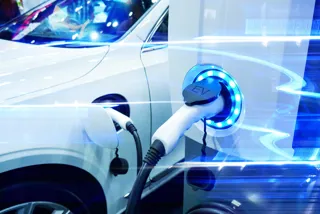Just 0.3% of all vans on Britain’s roads – some 12,300 out of 4.1 million vehicles – is considered an ultra-low emission vehicle (ULEV), new Department for Transport (DfT) data suggests.
The vast majority of them (96%) are powered by diesel, but the number of ultra-low emission vans – emitting 75g/km of CO2 or less – is increasing, having trebled in the past 12 years.
The findings are part of wider research commissioned by the DfT into the van sector for the first time since 2008 and 2009.
DfT road traffic estimates show that van travel has grown substantially over the past 25 years, increasing 106% to 55.5 billion vehicle miles in 2019.
Van travel as a proportion of all motor vehicle miles has increased from 10% to 16%, while the number of vans on Britain’s roads has grown by 93% over the same period.
The Ford Transit remains the most common make and model of van in Great Britain, with more than 960,000 licenced as of the end 2019.
Average annual mileage per van in GB (van vehicle miles divided by van stock) has remained broadly stable, at around 13,000 miles per year.
Meanwhile, the 2019-20 van survey found that just more than a quarter (27%) of vans were three years old or less, two-in-five (40%) were between three and 10 years old, and a third (33%) exceeded 10 years.
The DfT provisional statistics, which are compiled from responses to a questionnaire, using data on more than 17,600 vans driven by private and business operators, indicate that the age of vans kept varies greatly between the private and business sector.
More than half of vans (54%) driven by private owners were more than 10 years old, compared with 17% by business owners.
Across all van owners, the primary activity of the majority of GB’s annual van mileage (48%) was for ‘carrying equipment, tools or materials’.
‘Delivery/collection of goods’ was next at 23%, followed by ‘private/domestic non-business’ use at 10%.
Despite the increase seen in recent years in home deliveries, these 2019-20 figures are broadly similar to the previous study of van ownership in England in 2008.
In the 2008 study, 53% of mileage was attributed to ‘carrying equipment’, 26% to ‘delivery/collection’ and 9% to ‘private/domestic’ use.
The latest study saw the introduction of a new category – ‘recreational/leisure and holidays’, which made up 3% of all van mileage in 2019-20.
The scope for employing hybrid or fully electric vans appears to increase when the journey patterns of vans are revealed.
The provisional findings of the 2019-20 survey showed that half of all vans (50%) stayed local, within 15 miles of their base, on a typical day.
Just over a third of GB-based vans travelled regionally (34%), 14% travelled nationally and 1% internationally on a typical day.
However, vans used primarily for ‘transport’, ‘carrying equipment, tools or materials’ or the ‘delivery/collection of goods’ tended to travel further than 15 miles from base.
The group most likely to go further were vans used for ‘delivery or collection of goods’, with 61% of these travelling regionally or further on a typical day.
The data showed that those vans classed as ULEVs – typically battery electric (BEV) or plug-in hybrid electric vehicles (PHEVs) – were more likely to be used locally compared with diesel or petrol vans vans. On a typical day, 75% of ULEVs stayed within 15 miles of their base, compared with 50% of non-ULEVs. Only 1% of ULEVs travelled more than 50 miles away from their base on a typical day.
Reasons for not buying an electric van varied. Almost half (49%) cited the price, with the other most common reasons being vehicle suitability (43%), availability of charging points (38%) and the cost/availability of buying second-hand (33%).
In considering factors that would influence their next van purchase, two environmental factors were listed as very or quite important by a majority of respondents. However, overall, they were rated 7th and 10th most important, with 69% pointing to green concerns and 56% citing use of low emission/clean air zones.
A final report of the DfT’s findings will appear in the coming months.























Login to comment
Comments
No comments have been made yet.